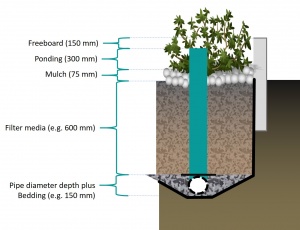Difference between revisions of "Planters: Sizing"
Jump to navigation
Jump to search
Dean Young (talk | contribs) |
Dean Young (talk | contribs) |
||
| Line 1: | Line 1: | ||
[[File:Sizing flow-through planter.jpg|thumb|A flow-through planter comprises a ponding zone, mulch layer, filter media for planting, and a supporting gravel drainage layer]] | [[File:Sizing flow-through planter.jpg|thumb|A flow-through planter comprises a ponding zone, mulch layer, filter media for planting, and a supporting gravel drainage layer]] | ||
| − | This article is specific to [[ | + | This article is specific to flow-through [[Stormwater planters| stormwater planters]], vegetated systems that do not infiltrate water to the native soil. <br> |
If you are designing a planted system which does infiltrate water, see advice on [[Bioretention: Sizing]]. | If you are designing a planted system which does infiltrate water, see advice on [[Bioretention: Sizing]]. | ||
Revision as of 01:21, 14 July 2020
This article is specific to flow-through stormwater planters, vegetated systems that do not infiltrate water to the native soil.
If you are designing a planted system which does infiltrate water, see advice on Bioretention: Sizing.
The dimensions of a stormwater planter are largely predetermined according to the function of the component. As they do not contain a storage reservoir the planters rely more upon careful selection of materials. Both the filter media and the perforations of the pipe play critical roles for flow control.
| Component | Recommended depth (with underdrain pipe) | Typical porosity (n) |
|---|---|---|
| Ponding (dp) | ≥ 300 mm | 1 |
| Mulch | 75 ± 25 mm |
|
| filter media (dm) |
|
0.35 |
| Pipe diameter reservoir | Is equal to underdrain pipe diameter | 0.4 |
| Pipe bedding (db) | 50 mm (although commonly omitted altogether). | 0.4 |
